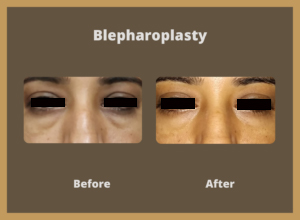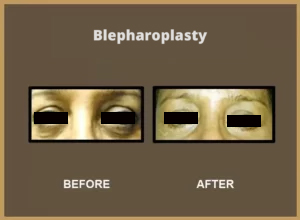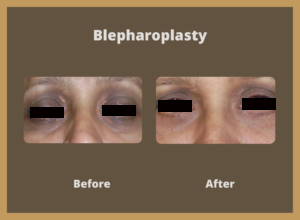Blepharoplasty
Your eyes also need life!
OUR RESULTS



Why Us?
Blepharoplasty or Cosmetic Eye Surgery is the plastic surgery of eyelids to correct defects, deformities or disfigurement of the eyelids, extra skin on eyelid, and for modifying the eye region of the face to enhance its aesthetic appearance. Blepharoplasty is the only permanent method to get rid of under eye bags often referred to as ‘Eye Bag Surgery’.
Book Appointment
During the procedure
If you have surgery on your upper and lower eyelids, the surgeon generally works on your upper lids first. The surgeon then cuts along the fold of the eyelid, removes some excess skin, muscle and fat, and closes the cut.
On the lower lid, the surgeon makes a cut just below the lashes in your eye’s natural crease or inside the lower lid and removes or redistributes excess fat, muscle and sagging skin, and closes the cut.
On the lower lid, the surgeon makes a cut just below the lashes in your eye’s natural crease or inside the lower lid and removes or redistributes excess fat, muscle and sagging skin, and closes the cut.
Frequently Asked Questions
If your eyelid droops close to your pupil, called ptosis (TOE-sis), your surgeon may do blepharoplasty with a procedure to address that problem. Blepharoplasty surgery usually takes less than two hours, depending on the amount and location of tissue being removed.
After surgery you spend time in a recovery room, where you are monitored for complications. You can leave later that day to recuperate at home.
Yes, a few which are temporary, including,
- Blurred vision from the lubricating ointment applied to your eyes
- Watering eyes
- Light sensitivity
- Double vision
- Redness where the cuts were made
- Puffy, numb eyelids
- Swelling and bruising similar to having “black eyes”
- Gently clean your eyelids and use prescribed eye drops or ointments
- Avoid straining, heavy lifting and swimming for a few days
- Avoid strenuous activities, such as aerobics and jogging, for a few days
- Avoid smoking
- Avoid rubbing your eyes
- Do not use contact lenses, for about two weeks after surgery.
- Wear dark tinted sunglasses to protect the skin of your eyelids from sun and wind.
- Sleep with your head raised higher than your chest for a few days.
- Apply cool compresses to reduce swelling.
- For a few days, avoid aspirin, ibuprofen, naproxen, and other medications or herbal supplements that may increase bleeding. If needed, use acetaminophen (Tylenol, others) to control pain.
